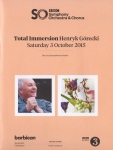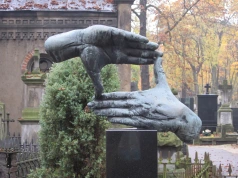• BBCSO Górecki: String Quartets

String Quartet no.1
String Quartet no.2
13.00, 3 October 2015
Silesian String Quartet
In the second half of his career, Górecki placed a special emphasis on chamber music. In his early years, he had written some trenchant works for duets, trios and quartets, including the brutalised neoclassicism of Sonata for Two Violins (1957), the gritty Genesis I: Elementi for violin, viola and cello (1962) and the punch-packed Little Music IV for trombone, clarinet, cello and piano (1970). His return to chamber music in the mid-1980s gave him a new lease of life after major surgery and was sparked by a commission from Denmark for Recitatives and Ariosos, ‘Lerchenmusik’ for clarinet, cello and piano. By this stage, his idiom was slightly more rounded without losing any of its potency. Within a couple of years he had embarked on the first of his three string quartets, which brought him to a much wider audience through the advocacy of Kronos Quartet and other ensembles, including the Silesian Quartet, which issued all three together for the first time in 2008.
String Quartet no.1 ‘Already It Is Dusk’ (1988)
All three of Górecki’s string quartets have descriptive titles. In this case, it is a variant of the opening line from Prayer for Children Going to Sleep, a motet by the Polish Renaissance composer Wacław z Szamotuł:
Already dusk is falling, night closes in,
Let us beseech the Lord for help,
To be our guardian,
To protect us from wicked devils,
Who especially under cover of darkness
Profit from their cunning.
After the striking opening chord (the basis for further passages) and a sustained A natural, Górecki presents the tenor line of the motet tranquillo, in a quasi-serial canon that is a throwback to his avant-garde youth. (He had borrowed from the motet twice before, notably in Old Polish Music, which opens this evening’s concert.) Although the tenor line is far removed from its original context, it may still be heard, appropriately enough, on the viola, which is marked sempre poco ‘en dehors’. Altogether, there are four developing altercations between chords and polyphony before the Allegro begins.
Marked Deciso – Energico, the main movement conjures up images of the sort of local music-making that Górecki so enjoyed in and around the village of Chochołów, where at the time he rented a wooden chalet, at the feet of Poland’s Tatra mountains. As in Bartók’s quartets, Górecki pairs the instruments not only to evoke folk-like melody and accompaniment but also to give an earthy, not to say astringent quality to the sound. In the third section of the Allegro, where melody returns to the viola and cello, Górecki recalls part of the motet’s tenor line. The fourth section drops melody altogether, as if hearing just the low drone of distant revelry, and gradually transforms itself into the chordal idea from the beginning. Górecki now unveils the full canon on the tenor line, tranquillissimo, and the quartet ends with a series of three different triads marked ARMONIA against which he tartly counterpoints the A natural from the start of the work.
String Quartet no.2 ‘Quasi una fantasia’ (1991)
The title ‘Quasi una fantasia’ properly belongs to the finale of this four-movement quartet, although its implications inform the whole piece. It links back loosely to the slow-fast-slow-fast structure of Beethoven’s Piano Sonata op.27 no.1 ‘Quasi una fantasia’. The first movement is a lament over low E naturals that extend almost to the end. Yet this is no soothing song of sorrow but a weeping soliloquy for viola against the cello’s tolling. When all four instruments come into play, Górecki does something rare in his music: he quotes himself, from the chordal drone in the First String Quartet (this passage recurs in the second movement). At the close, he introduces a cadential group of chords which he called ‘Beethovenian’, and these act individually and in consort as structural pillars of ‘Quasi una fantasia’.
The second movement builds on the folk-based idiom of its equivalent in the First Quartet (it even shares the same marking Deciso – Energico), especially in its motivic development and unpredictable sequence of repeats. Its final section is a near-repeat of the conclusion of the first movement. The ‘Arioso’ that follows is a salutory reminder that Górecki’s slow music is not all balm and calm. The high melodic parallelism is harsh and unforgiving and clashes with its harmonic context. Górecki said that he derived some of the material from Chopin’s posthumous Polonaise in D minor. If so, then he had, as in the First Quartet, a new-found determination to wring a contemporary expressivity out of his borrowed material when in earlier pieces like the Third Symphony he had treated it with gentle reverence. This ties in with the more developmental approach of his chamber music at this time. The ‘Beethovenian’ chords usher in the softer final bars, with their retrospective glances and comparative consonance.
Górecki viewed the finale as almost self-standing. Its unfolding sequence of exuberant dance-patterns certainly embodies the idea of a fantasia. He returns here to the tactic of pairing his instruments, whose several paragraphs are marked con grande passione, con bravura, furioso-marcatissimo. At the appearance of Agitato-Tumultuoso, Górecki unexpectedly slows the pace with the insertion of a descending chordal sequence and the music stutters before eventually recalling the first theme of the movement. There are a couple of surprises ahead, although the return at the very end to the work’s very beginning is the lesser of them. What remains an enigma is Górecki’s quotation of the first half of a well-known carol. He was fond of using an existing piece of music in the coda of his works (Old Polish Music, Symphonies no.2 and no.4), but this de-rhythmicised example is one of his most intriguing.
© 2015 Adrian Thomas
